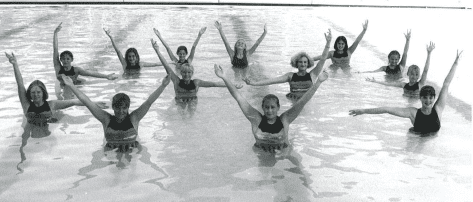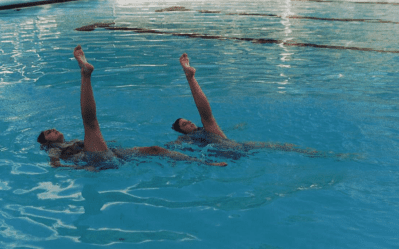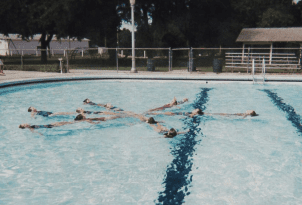From the water (or on the TV if watching the Olympics) synchronized swimming appears to be a graceful feat. Ballet-like movements performed where swimmers bob, tread, and float through the water – all in synch and perfectly timed to music.
But in reality, it’s a sport that requires athleticism, and in no small amount, says former lifeguard and synchronized swim coach, Sharon Beems.
“People think it’s kind of frivolous, but it is very difficult to do and requires lots of breath control and stamina,” she said. “There’s timing and I don’t think you realize how difficult that is unless you’ve done it.”

From sculling – hand movements that propel swimmers across the water (or under), to an eggbeater-like movement of the legs, far more intense than traditional treading, she said, it’s more than it appears from far away.
“It demands a lot of strength, endurance, and grace, along with some sort of style that goes with it,” said former head coach, Ronda Lloyd.
For more than a decade the pair of now-retired swimmers taught these techniques and produced an end-of-summer show for their local team, The Aquettes. Between the late 80s to the early 2000s, they ran the group at the former Clay Center Pool. It’s an idea that began when Lloyd returned to the area in 1987.
“It was kind of popular back in those days and it was beginning to be competitive,” she said. “And I liked it as a sport so I said, ‘Well let’s see if others like it,” and we did a show every year and had fun with it,” she said.
Both women worked as teachers – making the pool a fit for their summer schedules – and both had participated in synchronized swimming throughout college. With much in common, they became acquainted over a shared love of the water.
“I’ve been really fortunate because I’ve always done what I loved. I loved the pool, I loved art and I loved school, even as a kid,” Beems, a former USD 379 art teacher, said. “So I’ve been really fortunate I’ve got to do that my whole life.”
By the late 80s, they had recruited a group of local swimmers who wanted to learn and perform the sport of synchronized swimming. Groups of 10-20 girls of pre-teen to high school-aged swimmers would gather each summer.

“The kids really enjoyed it, picking the music, working on various stunts,” Lloyd said. “It was a fun thing to do.”
Practice was often early mornings – in a pool with no heater – or evenings, once the pool had closed. Members would gather multiple times a week, up to every day to prep for the end-of-season show.
“It was a busy time, but swimming has always been a passion of mine,” said Lloyd. “It was just something I always loved and felt it was a safe place for kids to come. I would work from 9 to 9 and had my three kids there too.”
The pair worked together to choreograph routines set to music that fit a common theme. Lloyd said the first-ever performance was themed Color My World, a throwback to a show she had done in college. Other themes included Lights, Camera, Action (1991), Musical Mystique (1996), Jungle Fever (1999), and Grease (2000).
“You can take it from any level, it can be a fun thing to do in the summer,” Lloyd said. “If they liked dance, it’s like dancing and gymnastics in the water.”
Throughout the years, Lloyd said there were students who tried synchronized swimming for a season or two, to those who practiced daily and were able to do advanced skills, such as treading water upside down, legs up in the air. Each swimmer wore nose plugs to help with breath-holding and stunts, but omitted goggles for the show for a more uniform look.

As an art teacher, Beems helped create elaborate scenes for the show, with team members helping to color and paint. Both said parents would come help set up for the show, too. For instance, with the Grease show, one parent made “leather” t-bird jackets out of trash bags.
“It was great, I loved it, I loved working with the girls,” said Beems, who also served as each show’s emcee, introducing each performing the next act.
She recalled one year, while coaching from the deck – calling out moves and counting – she walked right into the pool.
“That was to Desperado,” she said. “I’ll never forget that song because I did that. I was so focused and just kept going.”
With a large oval shape, swimmers were given plenty of space. However, Lloyd said they tried to be creative using the land and how swimmers would get into the water, such as dives or using the side of the pool to glide in. Gymnastics skills anyone could also be worked in, such as the year a swimmer did a handstand dive from one of the low boards.
Then each year, a night swim would be held after the show, where guests could get in additional swim time for just $2.
“That part was fun too, swimming with the lights on in the dark is just otherworldly,” Beems said. “Plus it was just something different and fun for everyone.”
The pair said eventually the program had run its course, with athletes who were overly committed to other activities. However, Lloyd said she is still asked about reviving a local synchronized swim chapter.
“I’ve toyed with the idea,” she said, adding she wouldn’t agree without Beems again at her side. “It’s something that’s always in the back of my mind, it was always so fun while we did it but I guess all good things must come to an end.”














